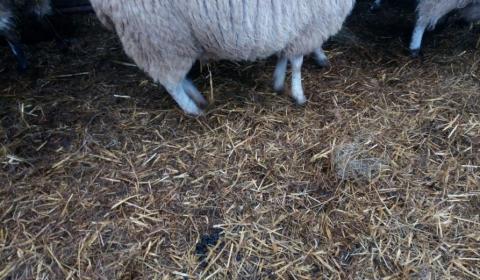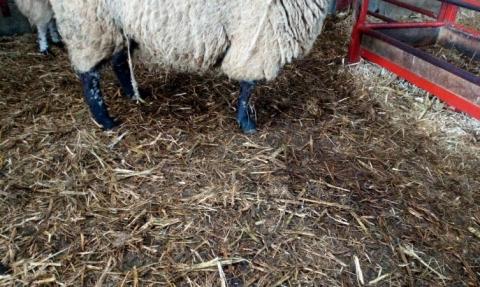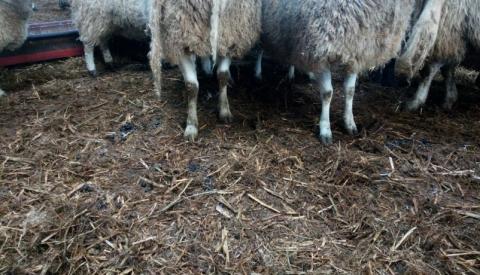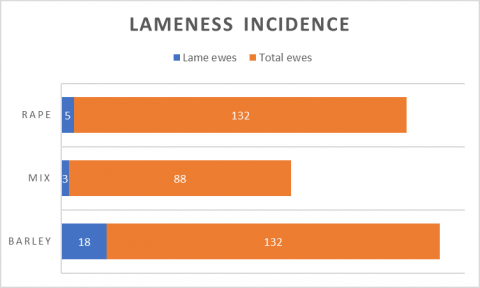Project update and results (May 2021): Straw bedding options for the lambing shed
Background
Eilir Jones and family were keen to investigate if there were any differences in sheep health between rape and cereal straw bedding for ewes in late pregnancy, particularly the incidence of lameness within the flock. The project also took into account the costs and usage of the straw types and also the nutrient value (phosphorus (P) and potassium (K)) of the resulting farmyard manure (FYM).
Around 350 ewes of mixed breeds (Texel cross, Suffolk cross, Mule cross and Speckle cross) carrying twins were housed from mid-January through until lambing, towards the end of March. The ewes were split into eight pens with between 43 and 45 ewes in each pen. Three pens were bedded with barley straw, three with rape straw and two with a layer of rape and then topped up with barley straw (mixed straw). Clean straw was supplied every five days on average.
Shed observations
Eilir monitored the outdoor, shed (ambient) and bedding temperatures daily. No differences were observed between the different beddings, with all showing similar temperatures.
Generally, the barley straw appeared to be the cleanest along with the mixed barley/rape. The rape straw appeared to be the dirtiest throughout the project. However, it is important to note that the rape straw was darker in colour than the barley, so it may just have appeared dirtier. Similar amounts of straw were used in each pen, with 12 bales of barley (each bale weighing approx. 450kg) used and 13 of rape (weighing approx. 400kg) straw throughout the project. There were no differences in ewe cleanliness within the pens.
Figure 1. Barley straw
Figure 2. Mixed straws
Figure 3. Rape straw
Ewes were observed to be foraging in all straws when fresh bedding was applied, but for longer in the barley straw. However, each pen received the same amounts of supplements and silage. Forage analysis was undertaken for each straw, with the barley having a higher nutritional value as expected.
|
|
Rape |
Barley |
|
Estimated metabolisable energy (ME) (MJ/kgDM) |
4.6 |
6.7 |
|
Crude protein(CP) (%) |
3.4 |
4 |
|
Dry matter (DM) (%) |
86.1 |
84.4 |
Sheep health
Overall, the ewes were in good condition and maintained the same condition throughout the housing period. There was a higher incidence of lameness in ewes on barley straw compared to rape straw. Eilir noted that muck/straw compacted on/in the ewes’ feet was significantly more on the barley and mixed straw pens compared to the rape straw pens. (4% of ewes were lame on rape bedding, 3% on rape/barley and 14% on barley alone).
Lameness is certainly an issue seen during housing in many flocks and is costly in terms of labour and treatments. A study conducted by the University of Warwick has shown that for flocks with 10% or more lame ewes, footrot losses alone equate to £6.35 per ewe/year, and for flocks with 5% or less lame ewes the cost is £3.90 per ewe/year. These costs include impaired performance, increased prevention/treatment costs and culling.
Nine ewes aborted their lambs within the last four weeks pre lambing, with post mortem results confirming toxoplasmosis and salmonella. Sources of these infections are unknown, but eight of these were found in the pens bedded with barley straw and one within the mixed straw pens. The rape straw was purchased directly off the field, whereas the barley straw had been stored prior to arriving at Talerddig Farm. There are no cats present at Talerddig Farm.
Straw cost
The straws were purchased at £85 per tonne for rape straw and £130 per tonne for barley. Similar amounts of straw were used (between 5 and 5.5t of each straw used), making rape the cheaper option.
Farm yard manure (FYM)
A pooled sample of FYM was taken from the pens and sent for analysis. The barley FYM was slightly higher in all nutrients, as seen below.
|
|
Rape straw |
Mixed straw |
Barley straw |
|
Dry matter (%) |
28.6 |
30.3 |
28.2 |
|
Total nitrogen (N) % |
2.41 |
2.39 |
2.59 |
|
Total phosphorus (P) % |
0.382 |
0.358 |
0.466 |
|
Total potassium (K) % |
2.77 |
2.93 |
3.13 |
|
Total magnesium (Mg) % |
0.418 |
0.425 |
0.559 |
The nutrients in manure are only partially available for plant growth and may or may not be useful. This depends on the time of application, but also on the type and form of manure.
Straw carbon footprint
The total production of rapeseed within England has been highly variable in the last few years, including a 127% annual increase in 2017, followed by a 62% annual decrease in 2019 (DEFRA, 2018, 2019).
Due to lower yields and ratio of straw to grain, oil seed rape has higher greenhouse gas (GHG) emissions per product (straw or seed) produced compared to both barley and wheat. However, the nutritional value of whole rapeseed is much higher (ME of 19.1 MJ/kgDM and 22% crude protein in DM) than whole barley (ME of 13.2 MJ/kgDM and 12.3% crude protein in DM), and rape straw has significantly more N and P than barley straw. It would be interesting to compare rapeseed to barley, taking these additional factors into account, rather than comparing on just yield.
Rape straw is unlikely to become a major source of bedding in the , since its production is directly linked to demand for rapeseed, and how that compares economically to other oilseeds across the world. However, if other benefits are taken into account, nutrient value of seed and straw, reduced cost and reduced lameness, then overall the rape straw could be both environmentally and economically viable.
Project conclusions
- Barley straw offered the cleanest bedding visually.
- Similar amounts of barley and rape straw were used.
- Fewer sheep were lame on the rape straw compared to the other straw options.
- There were only small differences in the nutrient value for FYM from both straws.
- Rape straw offered significant savings over barley straw as a bedding material for housed ewes in 2021.




